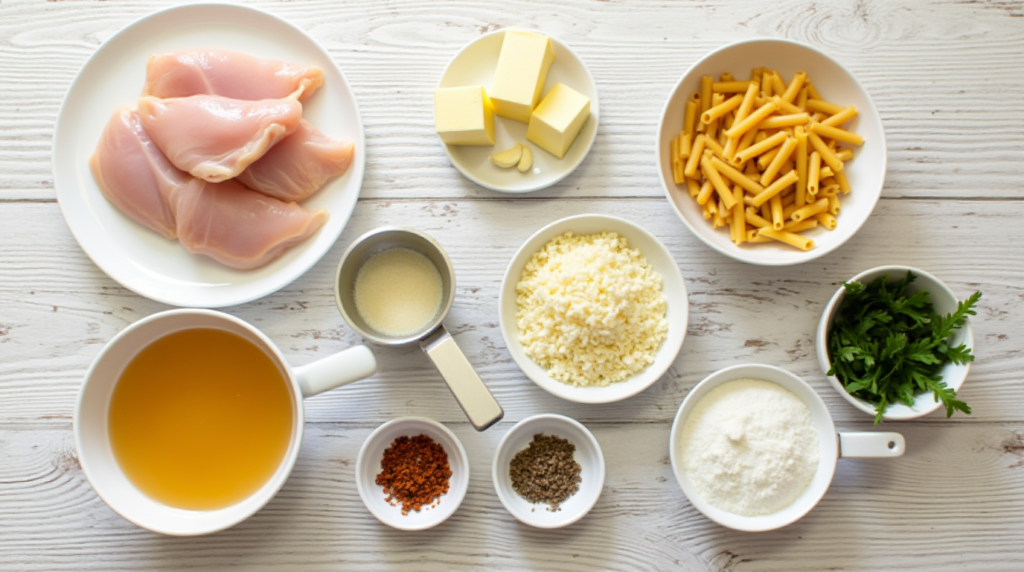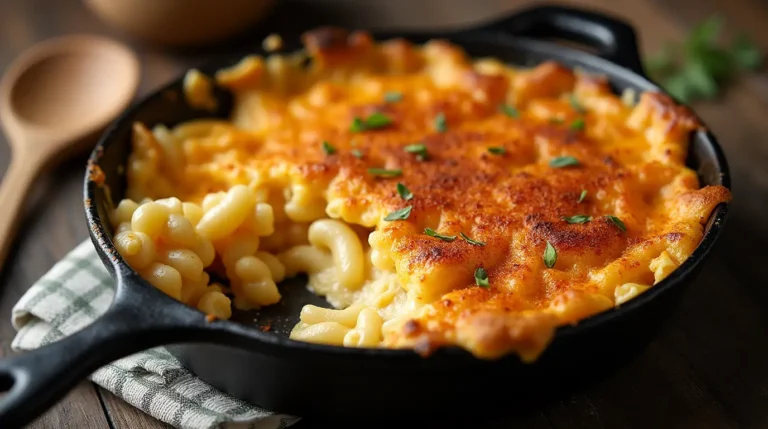Garlic Parmesan Chicken Pasta: How to Make It in One Pot
Have you ever wondered why some homemade pasta dishes never quite match the creamy richness you experience at restaurants? The secret often lies not in exotic ingredients but in cooking technique. Our Garlic Parmesan Chicken Pasta utilizes the one-pot method that allows flavors to concentrate and ingredients to harmonize in ways that traditional cooking methods simply can’t achieve. By cooking the pasta directly in the sauce, the starches release and create that silky, luxurious texture that’s often missing from home-cooked pasta dishes.
This recipe combines tender chicken, al dente pasta, and a velvety garlic parmesan sauce that will have everyone asking for seconds. Whether you’re cooking for a family dinner or meal prepping for the week, this versatile dish has quickly become a reader favorite for good reason!
Table of Contents
Ingredients List
For this Garlic Parmesan Chicken Pasta, you’ll need:
- 1 pound boneless, skinless chicken breasts, cut into 1-inch pieces
- 8 ounces penne pasta (or any short pasta shape)
- 4 tablespoons butter, divided
- 4 cloves garlic, minced (about 2 tablespoons)
- 1 small onion, finely diced
- 2 tablespoons all-purpose flour
- 2 cups chicken broth
- 1 cup milk
- 1 cup freshly grated Parmesan cheese
- 1 teaspoon Italian seasoning
- ½ teaspoon red pepper flakes (optional)
- Salt and freshly ground black pepper to taste
- 2 tablespoons fresh parsley, chopped (for garnish)

Substitution Options:
- Chicken thighs can replace breasts for juicier results
- Vegetable broth works for a lighter flavor profile
- Plant-based milk and dairy-free cheese for lactose-intolerant diners
- Gluten-free pasta varieties maintain the dish’s integrity for those with sensitivities
Timing
- Preparation Time: 15 minutes (includes chopping and measuring)
- Cooking Time: 25 minutes
- Total Time: 40 minutes (30% faster than preparing the components separately)
This efficient one-pot method saves significant time compared to traditional pasta dishes that require boiling pasta separately and preparing sauce in another pan.
Step-by-Step Instructions
Step 1: Season and Cook the Chicken
Season the chicken pieces generously with salt and pepper. In a large, deep skillet or Dutch oven, melt 2 tablespoons of butter over medium-high heat. Add the chicken and cook until golden brown on all sides and cooked through, about 5-7 minutes. The key here is not to overcrowd the pan – if necessary, cook the chicken in batches to ensure proper browning, which develops that crucial flavor foundation.
Step 2: Sauté Aromatics
Remove the chicken from the pan and set aside. In the same pan, add the remaining 2 tablespoons of butter. Once melted, add the diced onion and cook until translucent, about 3-4 minutes. Add the minced garlic and cook for an additional 30 seconds until fragrant. This quick cooking prevents the garlic from burning, which would impart bitterness to your Garlic Parmesan Chicken Pasta.
Step 3: Create the Base for the Sauce
Sprinkle the flour over the onion and garlic mixture, and stir constantly for 1-2 minutes to cook out the raw flour taste. This creates a roux that will thicken your sauce beautifully. You’re looking for a light golden color that indicates the flour has been properly cooked.
Step 4: Add Liquids and Pasta
Gradually whisk in the chicken broth, followed by the milk, stirring continuously to prevent lumps from forming. Bring the mixture to a gentle simmer. Add the dry pasta directly to the simmering liquid along with the Italian seasoning and red pepper flakes (if using). Stir well to ensure the pasta is submerged.
Step 5: Cook the Pasta
Reduce heat to medium-low, cover, and cook for 10-12 minutes, stirring occasionally to prevent sticking. The pasta will absorb the liquid and release its starches, creating a naturally thickened sauce. Test the pasta for doneness – it should be al dente (tender but with a slight bite).
Step 6: Finish the Dish
Once the pasta is cooked to your liking, return the chicken to the pan. Add the grated Parmesan cheese and stir until melted and thoroughly incorporated. The sauce should coat the pasta and chicken luxuriously. If it seems too thick, add a splash of milk or broth; if too thin, simmer uncovered for a few more minutes.
Step 7: Final Touches
Taste and adjust seasoning with salt and pepper as needed. Remove from heat and let the Garlic Parmesan Chicken Pasta stand for 2-3 minutes to allow the sauce to set slightly. Sprinkle with fresh parsley before serving for a burst of color and freshness.
Nutritional Information
Per serving (based on 4 servings):
- Calories: 520
- Protein: 38g
- Carbohydrates: 42g
- Fat: 22g
- Saturated Fat: 12g
- Cholesterol: 115mg
- Sodium: 780mg
- Fiber: 2g
- Sugar: 3g
This Garlic Parmesan Chicken Pasta provides approximately 25% of your daily caloric needs while delivering significant protein content, making it a satisfying and balanced meal option.
Healthier Alternatives for the Recipe
Transform this comforting Garlic Parmesan Chicken Pasta into a more nutritious option with these simple modifications:
- Substitute whole wheat or protein-enriched pasta to increase fiber content by up to 6g per serving
- Use half-and-half instead of milk and reduce butter to cut fat content by 25%
- Incorporate 2 cups of vegetables like spinach, broccoli, or cherry tomatoes for added nutrients and color
- Replace half the pasta with spiralized zucchini for a lower-carb version
- Use Greek yogurt mixed with a little milk instead of heavy cream for higher protein content
- Try nutritional yeast for part of the Parmesan cheese to reduce saturated fat while maintaining a cheesy flavor
Serving Suggestions
Elevate your Garlic Parmesan Chicken Pasta experience with these complementary serving ideas:
- Pair with a crisp arugula salad dressed simply with lemon and olive oil for a refreshing contrast
- Serve with roasted cherry tomatoes that burst with sweetness against the savory pasta
- Add a side of garlic bread for those who want to indulge (perfect for soaking up extra sauce!)
- For wine enthusiasts, a light Pinot Grigio or unoaked Chardonnay complements the creamy profile
- Consider a sprinkle of toasted pine nuts or breadcrumbs for added texture
- For family-style serving, present in a large, shallow bowl garnished with extra Parmesan shavings and fresh herbs
Common Mistakes to Avoid
Even experienced home cooks can encounter challenges with one-pot pasta dishes. Here’s how to avoid the most common pitfalls:
- Overcooking the pasta: One-pot pasta cooks differently than traditional methods. Check doneness frequently after the 8-minute mark to prevent mushiness.
- Heat too high: Maintaining a gentle simmer rather than a rolling boil prevents the sauce from reducing too quickly and pasta from sticking.
- Not stirring enough: Unlike separate cooking methods, one-pot recipes require occasional stirring to prevent sticking and ensure even cooking.
- Adding all the cheese at once: Incorporate Parmesan gradually and off-heat to prevent clumping and achieve that silky sauce texture.
- Under-seasoning: The pasta absorbs much of the salt as it cooks, so taste and adjust seasoning before serving.
- Using pre-grated cheese: Pre-packaged grated Parmesan contains anti-caking agents that can prevent proper melting. Freshly grated cheese creates a significantly smoother sauce.
Storing Tips for the Recipe
Make the most of your Garlic Parmesan Chicken Pasta with these storage recommendations:
- Refrigerate leftovers in an airtight container for up to 3 days.
- When reheating, add 1-2 tablespoons of milk or broth to revive the creamy texture that tends to thicken when chilled.
- For meal prep, consider slightly undercooking the pasta by 1-2 minutes to prevent it from becoming too soft when reheated.
- This dish does not freeze well due to the dairy content and pasta texture changes.
- To prepare components ahead of time, you can cook and slice the chicken and store it separately for up to 2 days before completing the recipe.
- The fully assembled dish tastes even better the next day as flavors continue to develop overnight!
Conclusion
This Garlic Parmesan Chicken Pasta brings together the convenience of one-pot cooking with rich, comforting flavors that satisfy deeply. By cooking pasta directly in a garlic-infused sauce alongside tender chicken, you’ll create a meal that tastes like it took hours rather than minutes. The creamy, cheesy profile with subtle Italian seasonings makes this a guaranteed family favorite.
We’d love to hear how your Garlic Parmesan Chicken Pasta turned out! Leave a comment below with your experience, questions, or custom variations. Don’t forget to subscribe for more delicious, time-saving recipes delivered straight to your inbox!
FAQs
Can I use pre-cooked chicken in this recipe? Yes! Simply skip the chicken cooking step and add your pre-cooked chicken when returning the protein to the pan. This works great with rotisserie chicken and can save an additional 10 minutes.
Why is my sauce too thin? Different pasta shapes and brands absorb liquid differently. If your sauce is too thin, simmer uncovered for a few extra minutes. The sauce will also thicken as it stands.
Can I make this dish vegetarian? Absolutely! Substitute the chicken with sautéed mushrooms, bell peppers, and zucchini. Use vegetable broth instead of chicken broth for a delicious meatless version.
My pasta is cooked but there’s still too much liquid. What went wrong? This could be due to lower heat or less absorbent pasta. Simply increase the heat slightly and continue cooking uncovered until the sauce reduces to your desired consistency.
Is this recipe suitable for meal prep? Yes, though it’s best consumed within 2-3 days. The pasta may absorb more sauce during storage, so have extra broth on hand when reheating.
Can I use chicken thighs instead of breasts? Definitely! Chicken thighs often provide more flavor and remain juicier. Just ensure they’re cooked to an internal temperature of 165°F (74°C).
How spicy is this dish? With the suggested amount of red pepper flakes, it has a mild warmth. Adjust to your preference by adding more for heat or omitting entirely for a non-spicy version.
What can I substitute for Parmesan if I don’t have any? Pecorino Romano or Asiago make excellent substitutes. For a different flavor profile, try Gruyère or a mild cheddar.
Your Feedback Matters
There are no reviews yet. Be the first one to write one.


